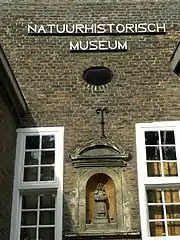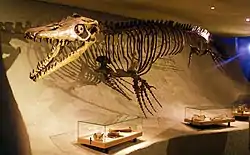Maastricht Natural History Museum
Maastricht Natural History Museum (Dutch: Natuurhistorisch Museum Maastricht) is a museum of natural history in Maastricht, Netherlands. The museum is located in a former monastery called Grauwzustersklooster (English: Monastery of the Grey Sisters) in the historic district Jekerkwartier in the centre of Maastricht.
Natuurhistorisch Museum Maastricht | |
 Front of the museum in 2010 | |

| |
| Location | De Bosquetplein 7[1] Maastricht, Netherlands |
|---|---|
| Coordinates | 50.8449°N 5.6878°E |
| Type | Natural history museum |
| Visitors | 28,614 (2013)[2] |
| Director | Stef Niekamp[3] |
| Website | nhmmaastricht |
The collection is dedicated to the geology, paleontology, flora and fauna of South Limburg. Highlights from the collection are Cretaceous fossils from Sint-Pietersberg, most notably the skull of a Mosasaur (nicknamed "Bèr") and specimens of Hoffmann's giant turtle, Allopleuron hofmanni and Suyckerbuyk's turtle, Glyptochelone suyckerbuyki. The museum also has a period room with cabinets of curiosities. A remarkable piece from that collection is a rat king from the 19th century.
Behind the museum is a botanical garden, situated on the banks of the small river Jeker.

References
- "Hoe kom ik er?" (in Dutch), Maastricht Natural History Museum. Retrieved 6 October 2017.
- "Integraal jaarverslag van Centre Céramique, Kumulus en Natuurhistorisch Museum Maastricht over 2013" (in Dutch), Centre Céramique/ISSUU, 2014. Retrieved 6 October 2017.
- "Wie is wie?" (in Dutch), Maastricht Natural History Museum. Retrieved 6 October 2017.
External links
- Official website
 Media related to Natural History Museum of Maastricht at Wikimedia Commons
Media related to Natural History Museum of Maastricht at Wikimedia Commons